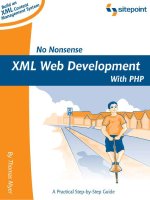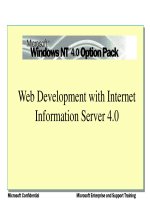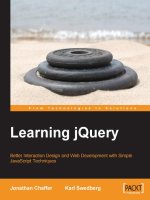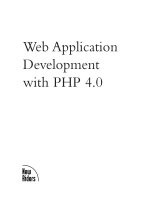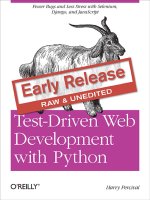No Nonsense XML Web Development With PHP potx
Bạn đang xem bản rút gọn của tài liệu. Xem và tải ngay bản đầy đủ của tài liệu tại đây (1.33 MB, 146 trang )
No Nonsense XML Web Development With PHP
(Excerpt)
Thank you for downloading this excerpt from Thomas Myer’s
book, No Nonsense XML Web Development With PHP, published by
SitePoint.
This excerpt includes the Summary of Contents, Information
about the Author, Editors and SitePoint, Table of Contents, the
Preface, and Chapters 1 through 4.
We hope you find this information useful in evaluating this book.
For more information or to order, visit sitepoint.com
Summary of Contents of this Excerpt
Preface ix
1. Introduction to XML 1
2. XML in Practice 33
3. DTDs for Consistency 59
4. Displaying XML in a Browser 81
Index 339
Summary of Additional Book Contents
5. XSLT in Detail 107
6. Manipulating XML with JavaScript/DHTML 137
7. Manipulating XML with PHP 163
8. RSS and RDF 199
9. XML and Web Services 221
10. XML and Databases 245
A. PHP XML Functions 261
B. CMS Administration Tool 297
No Nonsense XML Web
Development With PHP
by Thomas Myer
No Nonsense XML Web Development With PHP
by Thomas Myer
Copyright © 2005 SitePoint Pty. Ltd.
Index Editor: Bill JohncocksManaging Editor: Simon Mackie
Cover Designer: Julian CarrollTechnical Director: Kevin Yank
Cover Illustrator: Lucas LicataTechnical Editor: Joe Marini
Editor: Georgina Laidlaw
Printing History:
First Edition: July 2005
Notice of Rights
All rights reserved. No part of this book may be reproduced, stored in a retrieval system or transmitted
in any form or by any means, without the prior written permission of the publisher, except in the
case of brief quotations embodied in critical articles or reviews.
Notice of Liability
The author and publisher have made every effort to ensure the accuracy of the information herein.
However, the information contained in this book is sold without warranty, either express or implied.
Neither the authors and SitePoint Pty. Ltd., nor its dealers or distributors will be held liable for any
damages to be caused either directly or indirectly by the instructions contained in this book, or by
the software or hardware products described herein.
Trademark Notice
Rather than indicating every occurrence of a trademarked name as such, this book uses the names
only in an editorial fashion and to the benefit of the trademark owner with no intention of infringe-
ment of the trademark.
Published by SitePoint Pty. Ltd.
424 Smith Street Collingwood
VIC Australia 3066.
Web: www.sitepoint.com
Email:
ISBN 0-9752402-0-X
Printed and bound in the United States of America
About The Author
Thomas Myer is the founding principal of Triple Dog Dare Media, an Austin, TX-based
Web consultancy that specializes in building database- and XML-driven dynamic sites.
He first entered the field of Web development in 1996 when he learned Perl. He was in-
troduced to XML shortly thereafter and has worked with it extensively to build document
repositories, search engine indexes, content portal taxonomies, online product catalogs,
and business logic frameworks.
About The Technical Editor
Joe Marini has been active in the Web and graphics software industries for more than 15
years. He was an original member of the Dreamweaver engineering team at Macromedia,
and has also held prominent roles in creating products such as QuarkXPress, mFactory’s
mTropolis, and Extensis QX-Tools. Today Joe is a Senior Program Manager at Microsoft.
About The Technical Director
As Technical Director for SitePoint, Kevin Yank oversees all of its technical publica-
tions—books, articles, newsletters and blogs. He has written over 50 articles for SitePoint
on technologies including PHP, XML, ASP.NET, Java, JavaScript and CSS, but is perhaps
best known for his book, Build Your Own Database Driven Website Using PHP & MySQL,
also from SitePoint. Kevin now lives in Melbourne, Australia. In his spare time he enjoys
flying light aircraft and learning the fine art of improvised acting. Go you big red fire engine!
About SitePoint
SitePoint specializes in publishing fun, practical and easy-to-understand content for Web
professionals.
Visit to access our books, newsletters, articles and community
forums.
anyway.
To my three pups: big quiet
Kafka, little rascal Marlowe,
and for regal Vladimir, who
passed away the day after I
finished Chapter 5.
ii
Table of Contents
Preface ix
Who Should Read this Book? x
What’s in this Book? x
The Book’s Website xii
The Code Archive xii
Updates and Errata xiii
The SitePoint Forums xiii
The SitePoint Newsletters xiii
Your Feedback xiii
Acknowledgements xiv
1. Introduction to XML 1
An Introduction to XML 1
What is XML? 2
Why Do We Need XML? 2
A Closer Look at the XML Example 6
Formatting Issues 12
Well-Formedness and Validity 13
Getting Your Hands Dirty 15
Viewing Raw XML in Internet Explorer 16
Viewing Raw XML in Firefox 20
Options for Using a Validating Parser 20
What if I Can’t Get a Validating Parser? 23
Starting Our CMS Project 23
So… What’s a Content Management System? 23
Requirements Gathering 24
Defining your Content Types 28
Gathering Requirements for Content Display 31
Gathering Requirements for the Administrative Tool 32
Summary 32
2. XML in Practice 33
Meet the Family 33
A Closer Look at XHTML 35
A Minimalist XHTML Example 38
XML Namespaces 39
Declaring Namespaces 39
Placing Namespace Declarations in your XML Documents 40
Using Default Namespaces 41
Using CSS to Display XML In a Browser 42
Getting to Know XSLT 44
Your First XSLT Exercise 44
Transforming XML into HTML 50
Using XSLT to Transform XML into other XML 52
Our CMS Project 55
News 56
Summary 58
3. DTDs for Consistency 59
Consistency in XML 59
What’s the Big Deal About Consistency? 60
DTDs 61
Getting Our Hands Dirty 69
Our First Case: A Corporate Memo 70
Second Case: Using an External DTD for Memos 76
Our CMS Project 77
Reworking the Way we Track Author Information 77
Assign DTDs to our Project Documents? 79
Summary 80
4. Displaying XML in a Browser 81
A Word on XPath 81
A Practical XSLT Application 83
A First Attempt at Formatting 84
Using XPath to Discern Element Context 87
Matching Attribute Values with XPath 88
Using value-of to Extract Information 90
Our CMS Project 92
Why Start with the Display Side? 93
Creating a Common Include File 93
Creating a Search Widget Include File 94
Building the Homepage 94
Creating an Inner Page 102
Summary 104
5. XSLT in Detail 107
XPath 107
Programmatic Aspects of XSLT 110
Sorting 110
Counting 116
Numbering 117
Conditional Processing 121
Looping Through XML Data 125
Order the print version of this book to get all 350+ pages!iv
No Nonsense XML Web Development With PHP
Our CMS Project 126
Finishing our Search Engine 127
Creating an XSLT-Powered Site Map 130
Summary 136
6. Manipulating XML with JavaScript/DHTML 137
Why Use Client-Side Scripting? 137
Working with the DOM 138
Loading Documents into Memory 138
Accessing Different parts of the Document 140
XSLT Processing with JavaScript 142
Making our Test Script Cross-Browser Compatible 146
Creating Dynamic Navigation 151
Our CMS Project 157
Assigning Content to Categories 158
Retrieving Content by Category 158
Summary 161
7. Manipulating XML with PHP 163
Using SAX 164
Creating Handlers 166
Creating the Parser and Processing the XML 167
Using DOM 169
Creating a DOM Parser 169
Retrieving Elements 170
Creating Nodes 173
Printing XML from DOM 174
Using SimpleXML 174
Loading XML Documents 175
The XML Element Hierarchy 176
XML Attribute Values 178
XPath Queries 179
Using SimpleXML to Update XML 179
Fixing SimpleXML Shortcomings with DOM 180
When to Use the Different Methods 181
Our CMS Project 181
The Login Page 182
The Admin Index Page 186
Working with Articles 187
Summary 197
8. RSS and RDF 199
What are RSS and RDF? 199
vOrder the print version of this book to get all 350+ pages!
What’s the Big Deal? 200
What Kind of Information Should be Featured in an RSS
Feed? 200
Before We Get Started 201
Creating Your First Basic RSS Feed 202
Telling the World about your Feed 204
Going Beyond the Basics 206
RDF and RSS 1.0 207
Adding Information with Dublin Core 210
When to use RSS 1.0 211
Parsing RSS Feeds 212
Parsing our Feed with SimpleXML 213
Our CMS Project 215
Creating an RSS Feed 215
Summary 219
9. XML and Web Services 221
What is a Web Service? 221
What’s the Big Deal? 222
What are Web Services Good At? 223
XML-RPC 224
The XML-RPC Data Model 225
XML-RPC Requests 228
XML-RPC Responses 230
What do we Use to Process XML-RPC? 231
SOAP 231
What we Haven’t Covered 233
Our CMS Project 233
Building an XML-RPC Server 234
Building an XML-RPC Client that Counts Articles 239
Building an XML-RPC Client that Searches Articles 241
Summary 243
10. XML and Databases 245
XML and Databases 245
Why use XML and Databases Together? 246
Relational Database? Native XML Database? Somewhere in
Between? 246
Converting Relational Data to XML 249
Using phpMyAdmin to Export XML 249
Using mysqldump to Export XML 251
Hand-Rolling an XML Converter 253
Order the print version of this book to get all 350+ pages!vi
No Nonsense XML Web Development With PHP
Our CMS Project 256
Building the MySQL Table 256
Building the PHP 257
Setting up a Cron Schedule to Run Periodically 259
Summary 260
1. PHP XML Functions 261
SAX Functions 261
Error Code Constants 261
Function Listing 262
DOM Functions 272
Object Listing 272
Function Listing 294
SimpleXML Functions 294
Function Listing 294
SimpleXMLElement Methods 295
2. CMS Administration Tool 297
Picking Up Where We Left Off 297
Managing Web Copy 297
Web Copy Index Page 299
Web Copy Creation Page 301
New Web Copy Processing Script 303
Web Copy Editing Page 305
Web Copy Update Processing Script 307
Web Copy Delete Processing Script 308
Managing News Items 309
News Item Index Page 310
News Item Creation Page 311
New News Item Processing Script 312
News Item Editing Page 314
News Item Update Processing Script 316
News Item Delete Processing Script 317
Managing Authors, Administrators, and Categories 318
Managing Authors 318
Managing Administrators 327
Managing Categories 331
Updating the Admin Index Page 336
Summary 337
Index 339
viiOrder the print version of this book to get all 350+ pages!
viii
Preface
Off and on, I run a workshop called XML for Mere Mortals. The title attracts an
audience that’s much wider than your typical Web developer needing to bone
up on the subject. I train technical writers, project managers, database geeks—even
the occasional business owner who’s trying to get a handle on the exciting possib-
ilities of XML.
If I had to give this book a subtitle, it would be, “XML for Mere Mortals,” because
every time I sat down to write a chapter, I tried to picture the kind of folks who
show up at my workshops—intelligent and curious, with a wide range of technical
proficiency, but all of them feeling a little overwhelmed by the terminology,
processes, and technologies surrounding XML. With any luck, this approach will
serve you well.
This book has two goals: to introduce readers to a large part of the XML world,
and to walk them, step by step, through the creation of an XML-powered Website.
Let’s talk about each of those goals in more detail.
If we were to take the time to introduce you to the entire spectrum of XML
technologies, it would take a book twice (or thrice) as big as the one you’re cur-
rently holding. There’s a lot to talk about when you start looking at XML, so I
had to pick my battles. For instance, you’ll notice that we discuss DTDs, but not
XML Schemas. We talk a lot about XPath, but we don’t cover XQuery or XLink.
The idea of this title is to get your feet (and perhaps your ankles, shins, and
knees) wet in the topic of XML, and to make you feel comfortable to go out and
learn even more.
The second goal involves building your own XML-powered Website. I build both
XML- and database-powered dynamic Websites for a living, and I tried to pour
as much as I know about the process into the limited space available. As we work
to build the project that’s developed through the course of this book, I’ll take
you through the requirements gathering and analysis phases, then show you how
to convert that information into real XML documents and working code. Yes,
we are building a content management system, but a simplified one without the
heavy workflow or other capabilities you see in other systems. Nevertheless, what
you’ll end up with is a simple, powerful system that can get a Website up and
running quickly.
Every time I teach a class or workshop, I feel that I learn as much from my stu-
dents as they learn from me—that, in fact, I learn more as I continue to teach.
Writing this book was very much like that, because it forced me to organize my
thoughts and approaches into a more coherent fashion.
I hope you find the book a useful introduction to the incredibly fascinating topic
of XML. I know that many experts won’t agree with the approaches I took here,
and I’d like to say that I can understand all your disagreements, but writing a
book for the novice requires that the concepts be presented from a slightly differ-
ent perspective. If you wish to provide me with feedback, or you have any ques-
tions, feel free to drop me a line:
Who Should Read this Book?
This book is intended for the XML beginner. You should have some working
knowledge of the Web, including HTML and some JavaScript skills, and experi-
ence with a server-side programming language.
In this book, we use PHP 5 on the server side, and I’ll assume that you have had
some exposure to PHP. However, I always try to explain what’s going on, partic-
ularly as I work with XML concepts with which you may have little or no past
experience.
If you’ve ever fiddled with JavaScript, worked with a database, set up an ecom-
merce system, or programmed in PHP, ASP, or Perl, you’ll likely have no problem
following what we do within these pages.
What’s in this Book?
Here’s what we’ll cover:
Chapter 1: Introduction to XML
This chapter introduces XML. We talk about elements, tags, attributes, en-
tities, and we get into semantics. We explore the difference between well-
formedness and validity, then get our hands dirty with some examples. We
also start gathering requirements for our project.
Chapter 2: XML in Practice
It’s time to meet the XML family, namely XHTML, XML Namespaces, and
Extensible Stylesheet Language Transformations (XSLT). In addition to
playing with these technologies, we gather the final requirements for our
project.
Order the print version of this book to get all 350+ pages!x
Preface
Chapter 3: DTDs for Consistency
This chapter is all about consistency. In particular, we look at Document
Type Definitions (DTDs), a language that describes the requirements that
are necessary for an XML document to be valid; that is, suitable for use in a
particular system. We finish the chapter by refining some of the requirements
we’ve gathered for our project.
Chapter 4: Displaying XML in a Browser
In this chapter, we talk about XSLT and how to use it to transform XML for
display in a browser. We explore some of the basics of XSLT and introduce
XPath. At the end of the chapter, we build many of the public display tem-
plates we’ll need for our project.
Chapter 5: XSLT in Detail
This chapter picks up where the last one left off. We delve much deeper into
the programmatic aspects of XSLT, such as foreach loops, conditionals,
sorting, counting, and using XPath. In our project, we use this knowledge to
leverage XPath on the server side, and to create an XSLT-driven site map.
Chapter 6: Manipulating XML with JavaScript/DHTML
Here, we learn how to manipulate XML with client-side tools. We learn about
the Document Object Model (DOM) and the differences between the
handling of XML in Internet Explorer as compared to Firefox and other
Mozilla-based browsers. On the project side of things, we add categories to
our content structure, and use client-side XML processing to allow users to
browse the site’s content by category.
Chapter 7: Manipulating XML with PHP
In the previous chapter, our work was mostly on the client side. Now we
tackle the server side, specifically addressing the question of PHP 5 as we
explore the differences between SAX, DOM, and SimpleXML function librar-
ies for working with XML. We further our project work as we start to build
our administrative tool files, including login/verification templates and article
create/update/delete templates.
Chapter 8: RSS and RDF
RSS is a hot topic right now. It provides a means for Website users to mon-
itor sites they don’t have time to visit regularly, and for Web applications to
make use of content that’s syndicated from third-party Websites and other
information sources. In this chapter, we delve into the specifics of the different
varieties of RSS that are available (including RDF, which forms the basis of
RSS 1.0), and discuss news aggregators, the parsing of feeds with PHP, and
xiOrder the print version of this book to get all 350+ pages!
What’s in this Book?
more. We finish the chapter with the addition of an RSS feed to our Web
project.
Chapter 9: XML and Web Services
It’s time to look at Web Services. The emphasis of this chapter is XML-RPC,
an older standard for Web Services that’s easy to work with, but we do
mention SOAP, a newer standard in this area. On the project side, we create
an XML-RPC server (and clients) that search for articles on our site.
Chapter 10: XML and Databases
This final chapter considers XML and databases. We talk about the need to
use databases and XML together, explore the differences between relational
and native XML databases, and investigate the task of storing XML inform-
ation in a database. We hand-roll an SQL-to-XML converter, then do the
same thing using a ready-made solution, phpMyAdmin. Lastly, we create a
MySQL backup system for our XML project files.
Appendix A: PHP XML Functions
This appendix contains a complete reference to the SAX, DOM, and Sim-
pleXML functions that PHP 5 supports for working with XML.
Appendix B: CMS Administration Tool
This appendix completes our work on the project’s administrative tools. We’ll
build forms and scripts to handle news items, Web copy, authors, adminis-
trators, and categories.
The Book’s Website
Located at the Website supporting this
book will give you access to the following facilities:
The Code Archive
As you progress through the text, you’ll note that most of the code listings are
labelled with filenames, and a number of references are made to the code archive.
This is a downloadable ZIP archive that contains complete code for all the ex-
amples presented in this book.
Order the print version of this book to get all 350+ pages!xii
Preface
Updates and Errata
The Errata page on the book’s Website will always have the latest information
about known typographical and code errors, and necessary updates for changes
to technologies.
The SitePoint Forums
While I’ve made every attempt to anticipate any questions you may have, and
answer them in this book, there is no way that any book could cover everything
there is to know about XML. If you have a question about anything in this book,
the best place to go for a quick answer is
vibrant and knowledgeable com-
munity.
The SitePoint Newsletters
In addition to books like this one, SitePoint offers free email newsletters.
The SitePoint Tech Times covers the latest news, product releases, trends, tips, and
techniques for all technical aspects of Web development. Anything newsworthy
in the worlds of XML or PHP will find its way into the pages of this newsletter.
The long-running SitePoint Tribune is a biweekly digest of the business and
moneymaking aspects of the Web. Whether you’re a freelance developer looking
for tips to score that dream contract, or a marketing major striving to keep abreast
of changes to the major search engines, this is the newsletter for you.
The SitePoint Design View is a monthly compilation of the best in Web design.
From new CSS layout methods to subtle PhotoShop techniques, SitePoint’s chief
designer shares his years of experience in its pages.
Browse the archives or sign up to any of SitePoint’s free newsletters at
/>Your Feedback
If you can’t find an answer through the forums, or you wish to contact us for any
other reason, the best place to write is We have a well-
xiiiOrder the print version of this book to get all 350+ pages!
Updates and Errata
manned email support system set up to track your inquiries, and if our support
staff are unable to answer your question, they send it straight to me. Suggestions
for improvement as well as notices of any mistakes you may find are especially
welcome.
Acknowledgements
Picture this scene: Simon Mackie (my very talented editor) calls me from Australia,
basically to tell me to buck up, stop whining, and please just finish the darn book.
Without Simon’s perseverance none of this would have been possible, especially
when I hit the wall around Chapter 8.
A colleague once told me that without deadlines, nothing would get done; that’s
still true, but I’d like to add that without great editing, no book would ever get
done.
Simon had a team of very smart reviewers who pored over every sentence and
illustration in this book. Without their sharp eyes, this book would have been a
shambling mess; their sound advice and good humor allowed me to stay on track
and keep the book to the highest standards of technical accuracy. Of course, I’m
pretty feisty and put up a good fight, but 90% of the time their logical good sense
prevailed over my natural instinct to bargain my way out of any compromise. To
make a long story short, any errors in this book are my fault, not theirs.
Of course, Simon had help, namely my wife Hope, who is herself one heck of an
editor. She cheerfully put up with my long absences as I plugged away on the
book. She celebrated when I met deadlines and hassled me if she caught me
slacking. She read over drafts and made suggestions, asked questions, and basically
pushed me when I most needed it. She is everything to me.
Order the print version of this book to get all 350+ pages!xiv
Preface
Introduction to XML
1
In this chapter, we’ll cover the basics of XML—essentially, most of the information
you’ll need to know to get a handle on this exciting technology. After we’re done
exploring some terminology and examples, we’ll jump right in and start working
with XML documents. Then, we’ll spend some time starting the project we’ll
develop through the course of this book: building an XML-powered content
management system.
An Introduction to XML
Who here has heard of XML? Okay, just about everybody. If ever there were a
candidate for “Most Hyped Technology” during the late 90s and the current
decade, it’s XML (though Java would be a close contender for the title).
Whenever I talk about XML with developers, designers, technical writers, or
other Web professionals, the most common question I’m asked is, “What’s the
big deal?” In this book, I’ll explain exactly what the big deal is—how XML can
be used to make your Web applications smarter, more versatile, and more
powerful. I’ll try to stay away from the grandstanding hoopla that has character-
ized much of the discussion of XML; instead, I’ll give you the background and
know-how you’ll need to make XML a part of your professional skillset.
What is XML?
So, what is XML? Whenever a group of people asks this question, I always look
at the individuals’ body language. A significant portion of the group leans forward
eagerly, wanting to learn more. The others either roll their eyes in anticipation
of hype and half-formed theories, or cringe in fear of a long, dry history of markup
languages. As a result, I’ve learned to keep my explanation brief.
The essence of XML is in its name: Extensible Markup Language.
Extensible
XML is extensible. It lets you define your own tags, the order in
which they occur, and how they should be processed or displayed.
Another way to think about extensibility is to consider that XML
allows all of us to extend our notion of what a document is: it can
be a file that lives on a file server, or it can be a transient piece
of data that flows between two computer systems (as in the case
of Web Services).
Markup
The most recognizable feature of XML is its tags, or elements (to
be more accurate). In fact, the elements you’ll create in XML will
be very similar to the elements you’ve already been creating in
your HTML documents. However, XML allows you to define
your own set of tags.
Language
XML is a language that’s very similar to HTML. It’s much more
flexible than HTML because it allows you to create your own
custom tags. However, it’s important to realize that XML is not
just a language. XML is a meta-language: a language that allows
us to create or define other languages. For example, with XML
we can create other languages, such as RSS, MathML (a mathem-
atical markup language), and even tools like XSLT. More on this
later.
Why Do We Need XML?
Okay, we know what it is, but why do we need XML? We need it because HTML
is specifically designed to describe documents for display in a Web browser, and
not much else. It becomes cumbersome if you want to display documents in a
mobile device or do anything that’s even slightly complicated, such as translating
the content from German to English. HTML’s sole purpose is to allow anyone
to quickly create Web documents that can be shared with other people. XML,
Order the print version of this book to get all 350+ pages!2
Chapter 1: Introduction to XML
on the other hand, isn’t just suited to the Web—it can be used in a variety of
different contexts, some of which may not have anything to do with humans in-
teracting with content (for example, Web Services use XML to send requests and
responses back and forth).
HTML rarely (if ever) provides information about how the document is structured
or what it means. In layman’s terms, HTML is a presentation language, whereas
XML is a data-description language.
For example, if you were to go to any ecommerce Website and download a product
listing, you’d probably get something like this:
<!DOCTYPE html PUBLIC "-//W3C//DTD XHTML 1.0 Transitional//EN"
" /><html xmlns=" /><head>
<title>ABC Products</title>
<meta http-equiv="Content-Type"
content="text/html; charset=iso-8859-1" />
</head>
<body>
<h1>ABC Products</h1>
<h2>Product One</h2>
<p>Product One is an exciting new widget that will simplify your
life.</p>
<p><b>Cost: $19.95</b></p>
<p><b>Shipping: $2.95</b></p>
<h2>Product Two</h2>
…
<h3>Product Three</h3>
<p><i>Cost: $24.95</i></p>
<p>This is such a terrific widget that you will most certainly
want to buy one for your home and another one for your
office!</p>
…
</body>
</html>
Take a good look at this—admittedly simple—code sample from a computer’s
perspective. A human can certainly read this document and make the necessary
semantic leaps to understand it, but a computer couldn’t.
3Order the print version of this book to get all 350+ pages!
Why Do We Need XML?



